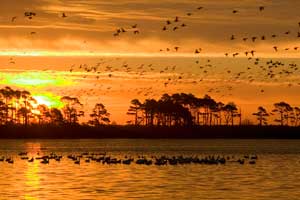Scientists track deadly bird flu around globe
December 2010 | Volume 9, Issue 6
Bird flu remains a serious threat to both wildlife and humans, killing at least 18 people this year alone. A multidisciplinary program supported by Fogarty and the National Science Foundation (NSF) is contributing to the ongoing global tracking of the virulent H5NI strain of human influenza, which kills about 60 percent of those it infects.

Photo by Steve Hillebrand/U.S. Fish and Wildlife Service
Scientists are learning more about wild birds and
their connection to the spread of H5N1, known
as bird flu.
Dr. Xiao Xiangming, a remote sensing expert and professor of botany and microbiology at the University of Oklahoma, heads the international surveillance project, funded under Fogarty's Ecology of Infectious Diseases initiative.
Since 2006, Xiangming and his colleagues have been developing an early warning system for detecting "hot spots" and "hot times" for the regions that are prone to risk. Xiangming's team uses a combination of epidemiology, ornithology, agriculture and environmental remote sensing. They also employ a wide range of tools including geographic information systems, GPS technologies, epidemiological models and internet technology to track the virus's spread.
The project has yielded useful information about the involvement of wild birds and their connection to the spread of H5N1. Using GPS data on migration paths and genomic analysis of the disease strains, the researchers were able to examine the relationships between the wild birds and domestic fowl. "All of them are increasing the opportunities for viral transmission and persistence," Xiangming told Science magazine recently. The team has identified probable transmission routes based on the migration paths and is now speculating on the location of the viral reservoir.
Widespread circulation of the avian flu virus increases the likelihood of its mutation into a form that could pass from person to person, potentially resulting in a new large-scale human flu pandemic.
Researchers such as Xiangming would like to better understand wild bird behavior, distribution and habitat use, in addition to the role of human factors like urbanization and population growth. The expanding poultry industry in Asia, farming, trade and mixing of different types of birds can all lead to an increase in disease transmission.
More Information
In China's Backcountry, Tracking Lethal Bird Flu, Science, 15 Oct. 2010, p. 313.
To view Adobe PDF files,
download current, free accessible plug-ins from Adobe's website.